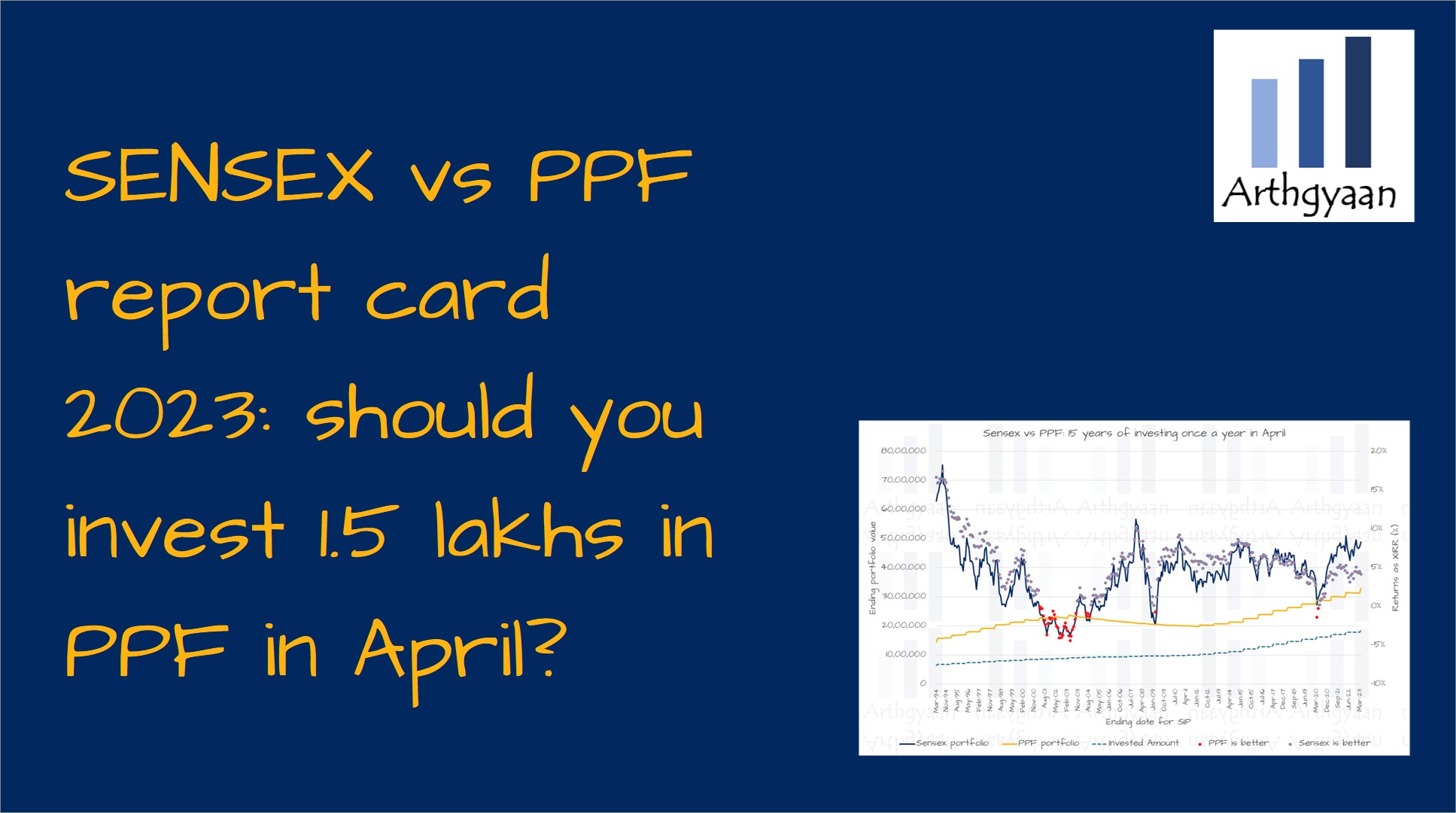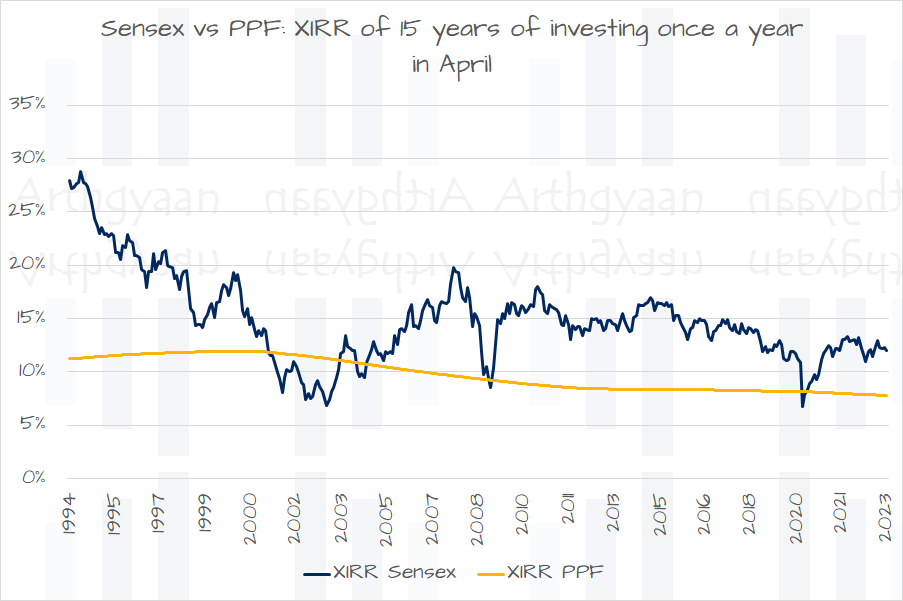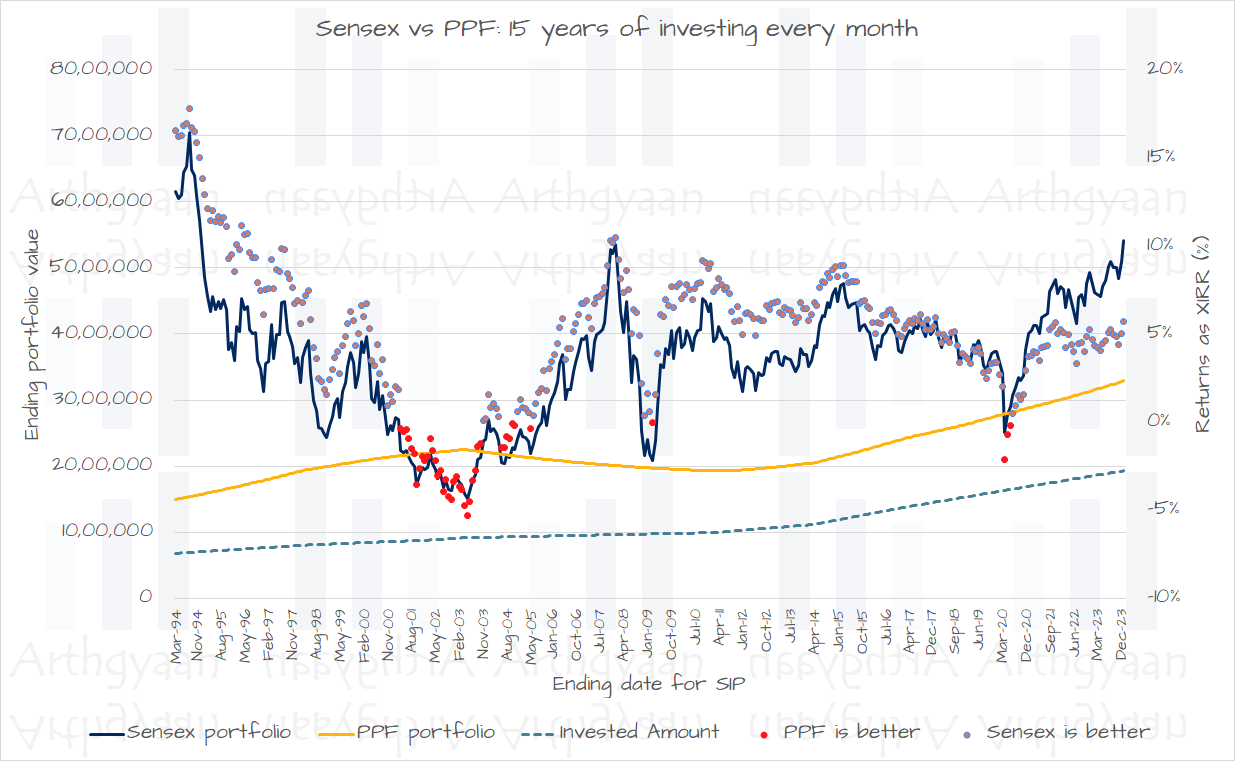SENSEX vs PPF report card 2023: should you invest 1.5 lakhs in PPF in April?
This article compares how the PPF has performed against the SENSEX since 1979 to help investors decide if they should invest a lump sum in PPF in April 2023.
This article compares how the PPF has performed against the SENSEX since 1979 to help investors decide if they should invest a lump sum in PPF in April 2023.

Many investors wonder which is a better option for long-term investment: Public Provident Fund or investing in the stock market via mutual funds. Given that PPF returns more the earlier you make the investment, many investors also try to target investing the maximum in PPF as early as possible, preferably in April.
This article is frequently updated. The latest version is here.
We run a simulation using historical data to check which option has been better. The simulation takes the case of two individuals
In this article, we will show the results of running a 15-year investment in PPF vs the Sensex (to represent stock investing via mutual funds) in this way:
We did not have mutual funds in 1979, but we have today, and not having mutual funds in the 1970s does not invalidate the conclusions below.
Using data from the National Savings Institute, we plot the historical interest rates and limits of PPF investment since 1968.

Some observations:
Here is another view of the same data but for every month since 1995:

We will invest the same amount at the beginning of the year on 1st April in PPF or Sensex. The amount will be equal to the maximum investment limit of PPF that was allowed at that time. Since PPF interest is calculated on the minimum balance between the 5th and the end of the month, this method maximises the interest we can get via investing monthly in PPF. The interest rate taken is the actual PPF rate in that period. We also use the actual Sensex Total Returns returns (Sensex price changes with reinvested dividends) for the final portfolio value over the period.

The result shows that in most of the 350 cases in this simulation, Mr S, the stock investor, comes out ahead. Only in some extreme market events, like the post-Harshad Mehta years, the 2008 global financial crisis or the 2020 COVID-19 crash, did the PPF portfolio do better in 9.43% cases or 33 out of 350 cases.

In this chart, we see how the returns of the PPF investment have risen and later fallen with PPF rates while that of the Sensex investment has been unpredictable.
We will invest the same amount at the beginning of the month in PPF or Sensex instead of a lump sum in April. The amount is 1/12th of the investment limit of PPF that was allowed at that time per month.

Here the result improves slightly for PPF with 9.19% or 33 out of 359 cases beating the Sensex.

Do not rush to invest ₹1.5 lakhs in PPF by 5th April. Investing equal amounts per month should be better.
It is true that you get the highest interest in PPF the earlier you invest. However, you might be losing out a large quantum of returns in equity by not investing enough.
We should keep in mind the following points while concluding anything from this analysis:
Can we use this data to say that “stocks are usually better than PPF”? That is mostly true. However, PPF has some benefits like guaranteed tax-free returns that stocks do not have.
We should not construct a portfolio for long-term goals only with stocks since we have shown before that the end result of such a portfolio is unknown.
To understand how to create a portfolio where the PPF investment amount is just right:
The better option is to create a portfolio with both debt and equity as asset classes and rebalance between the two per an appropriate glide path.
1. Email me with any questions.
2. Use our goal-based investing template to prepare a financial plan for yourself.Don't forget to share this article on WhatsApp or Twitter or post this to Facebook.
Discuss this post with us via Facebook or get regular bite-sized updates on Twitter.
More posts...Disclaimer: Content on this site is for educational purpose only and is not financial advice. Nothing on this site should be construed as an offer or recommendation to buy/sell any financial product or service. Please consult a registered investment advisor before making any investments.
This post titled SENSEX vs PPF report card 2023: should you invest 1.5 lakhs in PPF in April? first appeared on 02 Apr 2023 at https://arthgyaan.com